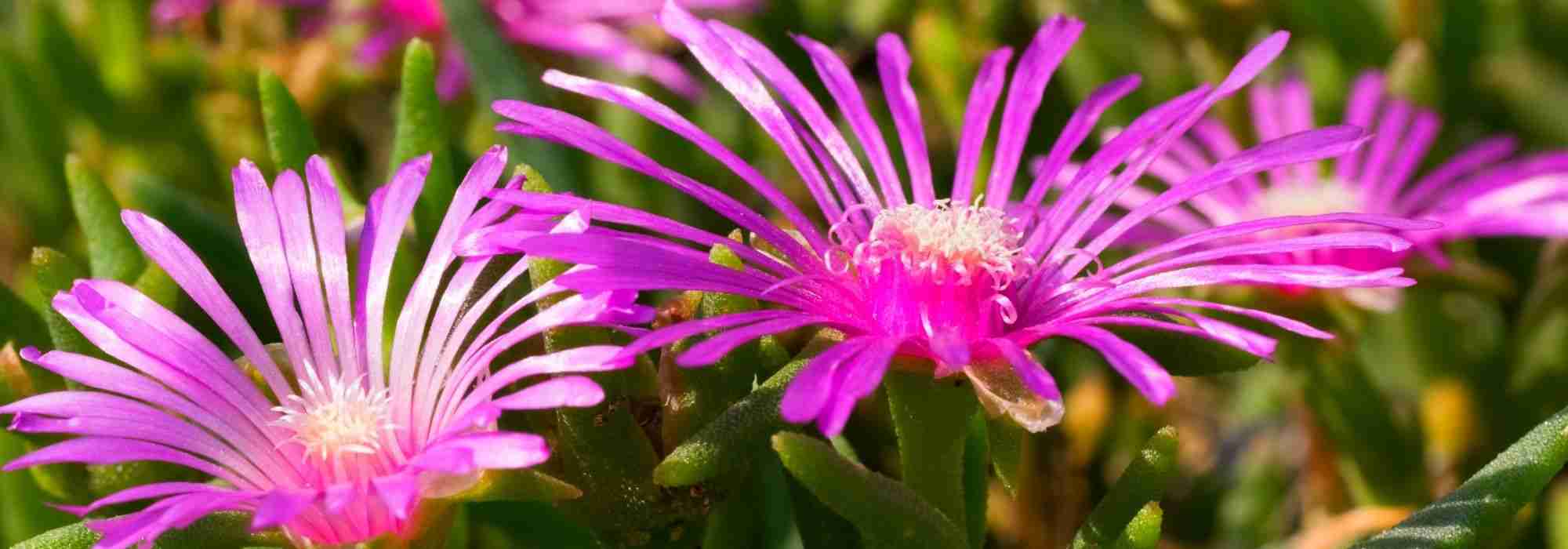
Associate the delosperma
5 companion planting ideas for perennial purslane
Contents
The delosperma or perennial purslane is a succulent plant that is drought-resistant and tolerant of sea spray. It is sometimes found by the sea, in sandy areas or rocky outcrops. With its brightly coloured flowers in shades of pink, purple, orange, yellow, or white and its small fleshy leaves, it is a groundcover that brings cheer to challenging spots, such as slopes or walls. Requiring little maintenance, it is also perfect for beginner or somewhat lazy gardeners. Outdoors, plant it only in regions where negative temperatures do not drop below –8°/-10° C. Discover our 5 pairing ideas for delosperma to add colour to your garden or balcony.
Find everything you need to know in our dedicated sheet: the Delosperma, perennial purslane: plant and grow
In a rockery
Delosperma forms colourful cushions between 8 and 15 cm in height and fits very well into a rockery. It flowers from June until the first frosts. If you live in a region where winters are not too harsh (maximum -8° C), plant the Delosperma cooperi or Cooper’s portulaca with its stunning small fuchsia flowers in a rockery. Reaching a height of 10 cm, it flowers from June to September. You can plant it with rockery flowers such as dianthus, creeping gypsophila, sedums, or valerian.
Consider the Dianthus gratianopolitanus ‘Kahori’ which forms small cushions of 15 cm and is covered in carmine pink, fragrant flowers from May to October. You can also combine these plants with Sedum album ‘Coral Carpet’, a miniature sedum 8 cm tall that produces small white or cream-pink flowers in June and July.
If you prefer slightly taller plants, opt for Gypsophila repens ‘Alba’ which produces small white flowers from June to August, as well as garden valerian or Centranthus ruber offering corymbs of tiny carmine flowers from May to August.
If you enjoy colour combinations of yellow and purple, you can plant the Delosperma Wheels of Wonder ‘Golden’ alongside the agapanthus ‘Charlotte’ which features blue-violet flowers from June to September. You can accompany them with blue fescues to maintain bluish-grey tones.

Delosperma cooperi, Sedum album ‘Coral Carpet’, Gypsophila repens ‘Alba’, Centranthus ruber and Dianthus gratianopolitanus ‘Kahori’
On a a wall or in a stone trough
Enjoy the beauty of delosperma flowers to brighten up a wall or an old stone trough. Delosperma requires very little and can even settle in the crevices between stones if it finds a bit of available soil.
On a wall, you can plant Delosperma cooperi ‘Table Mountain’. At a height of 8 cm, it produces fuchsia flowers from June to September. Also adorn the wall with Sedum spurium ‘Album Superbum’, a groundcover that reaches 10 cm in height and is covered in white flowers from June to July. The wall campanulas with their light mauve bell-shaped flowers can also be planted on a wall. Their lovely flowering occurs from June to September. A great advantage of these groundcovers is their ability to form small cascades of flowers spilling over the edges of the wall.
In a stone trough, you can also create colourful compositions of drought-resistant and sun-loving flowers. Combine the Delosperma cooperi in bright pink, with Phlox subulata ‘Emerald Cushion Blue’, a low-growing perennial that offers light blue flowers from April to June. For example, add the Gaura lindheimeri ‘Snowbird’ in white, as well as true lavender for its purple flowers or lavender ‘The Princess’ if you want to try this novelty with bright pink flowers.
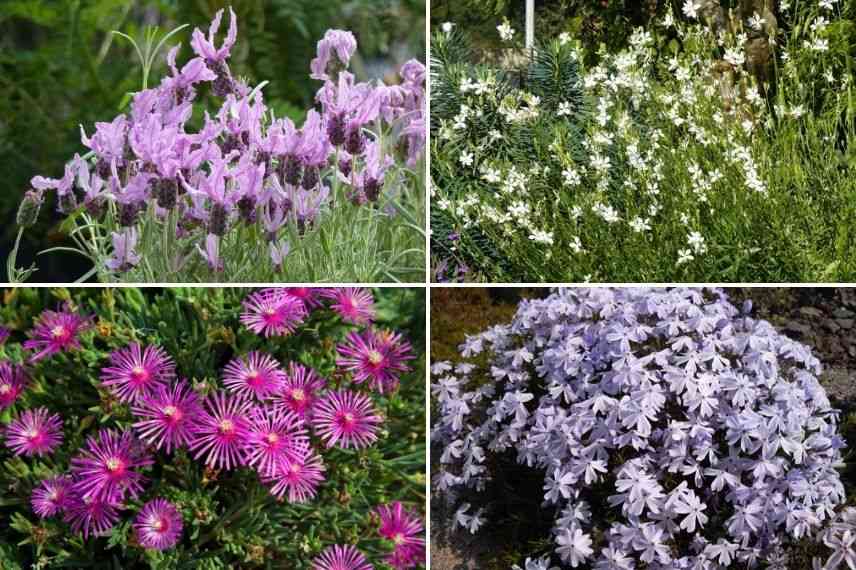
Lavender ‘The Princess’, Gaura lindheimeri ‘Snowbird’, Delosperma cooperi, and Phlox subulata ‘Emerald Cushion Blue’ (photo Wikipedia)
Discover other Delosperma
View all →Available in 0 sizes
Available in 2 sizes
Available in 2 sizes
Available in 2 sizes
Available in 2 sizes
Available in 1 sizes
Available in 2 sizes
Available in 1 sizes
Available in 2 sizes
Available in 1 sizes
In a sandy bed or a border by the sea
Semi-hardy, the perennial purslanes should be planted outdoors preferably in Mediterranean or Atlantic coastal regions.
If you live by the sea, delosperma is ideal for a border or in a bed with sandy soil. Pair it with other delospermas for a stunning visual effect and a festival of bright colours. Combine the Delosperma cooperi with the remarkable Wheels of Wonder series of purslanes: Delosperma Wheels of Wonder ‘Fire’, ‘Golden’, ‘Hot Pink’, and ‘Violet’ for a garden that catches the eye at first glance!
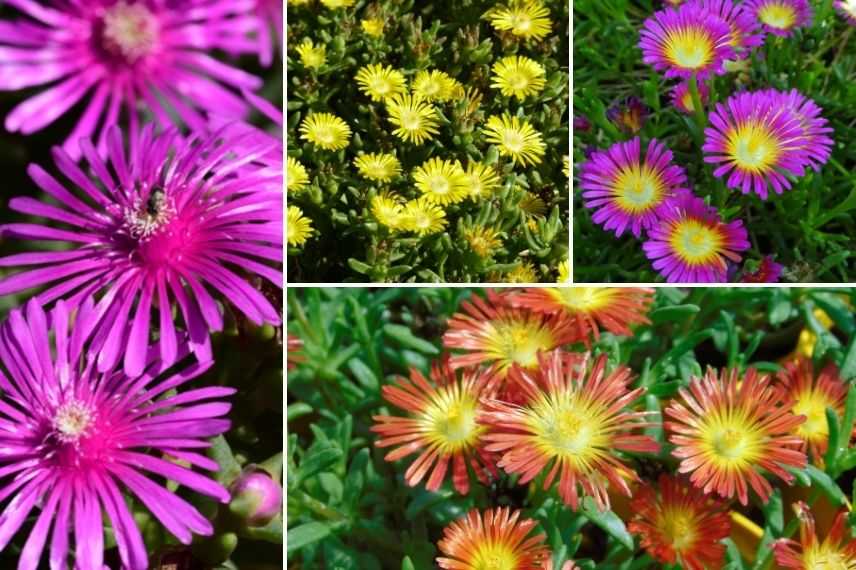
Delosperma cooperi, Delosperma Wheels of Wonder ‘Golden’, Delosperma Wheels of Wonder ‘Hot Pink’, and Delosperma Wheels of Wonder ‘Fire’
Read also
Growing a Delosperma in a potIn a dry garden of palms and yuccas
You can also use delosperma as a groundcover plant in a Mediterranean garden. Its small, brightly coloured flowering cushions create a stunning effect and adorn the bare bases of palms, yuccas, and cacti. Choose delosperma according to your preferences, based on colour.
In this dry garden, arrange the delospermas for example at the front of a bed formed of several dwarf palms (Chamaerops humilis), of American agaves and filamentous yucca (Yucca filamentosa).
Among the delospermas from the ‘Wheels of Wonder’ collection that flower between June and September, you can choose from orange, yellow, white, violet or bicoloured pink with a yellow centre. Another option is to choose Delosperma floribundum ‘Stardust’, lilac mauve with a white centre, revealing its flowering from May to October. Let’s not forget the Delosperma cooperi which produces bright pink flowers with a white centre, from June to September. You can also plant a mix of different colours.
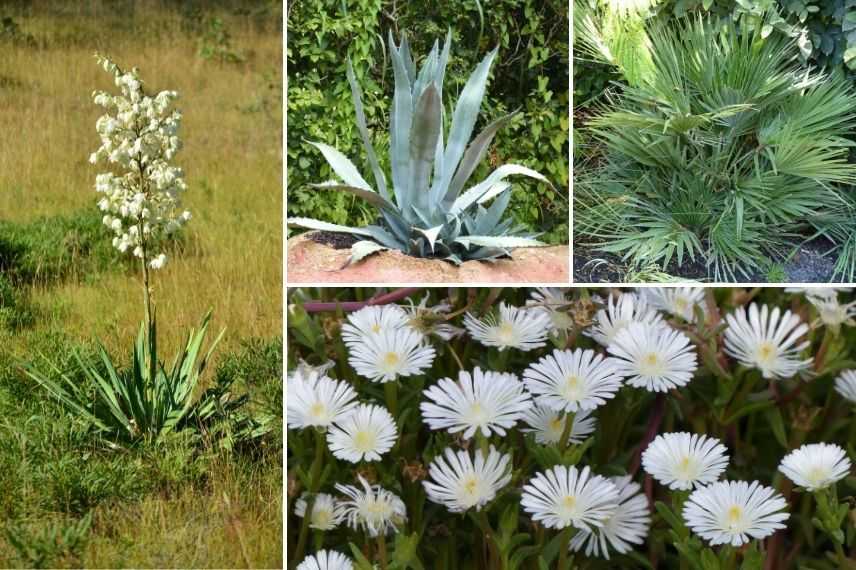
Yucca filamentosa, Agave americana, Chamaerops humilis and Delosperma Wheels of Wonder ‘White’
In a well-drained pot or a hanging basket
If you’re looking for a low-maintenance plant for a pot, delosperma is an excellent choice. Place it in a very well-drained substrate topped with gravel and position the pot in full sun. Pair Delosperma ‘Wheels of Wonder ‘Hot Pink’ with Sempervivum tectorum and Sedum sieboldii with grey-blue foliage. Both produce dark pink flowers in September and October. Houseleeks thrive well in pots. For example, consider Sempervivum ‘Chick Charms Gold Nugget’ with its vibrant yellow and orange colours. The Echinopsis subdenudata also finds its place in this display. Feel free to create your plantings in a hanging pot to create stunning floral cascades.
Another idea for a large pot: you can plant delosperma at the base of a bush. For instance, fill the base of a dwarf buddleia such as Buddleia x davidii ‘Lilac Chip’ with purple flowers alongside Delosperma Wheels of Wonder ‘Orange’ or Delosperma Wheels of Wonder ‘Golden’.
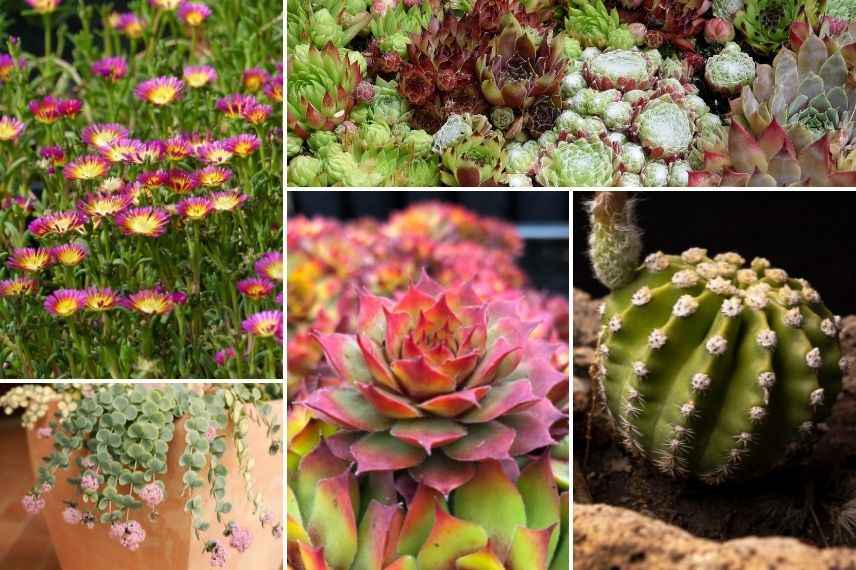
Delosperma Wheels of Wonder ‘Hot Pink’, Sempervivum tectorum, Sedum sieboldii, Sempervivum ‘Chick Charms Gold Nugget’ and Echinopsis subdenudata
For further reading
- To learn all about delosperma, check out our comprehensive sheet dedicated to this lovely plant
- Find our complete collection of delospermas on our site
- To avoid any failures, we recommend planting appropriately; feel free to adopt our Plantfit web application!
- Subscribe!
- Contents

































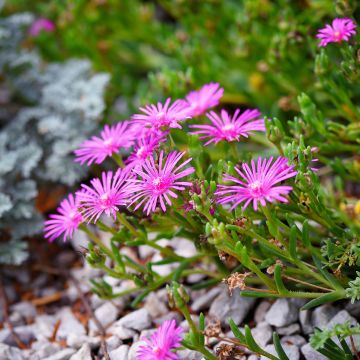



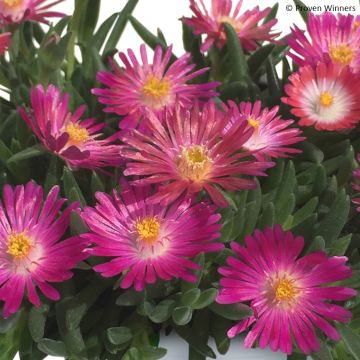


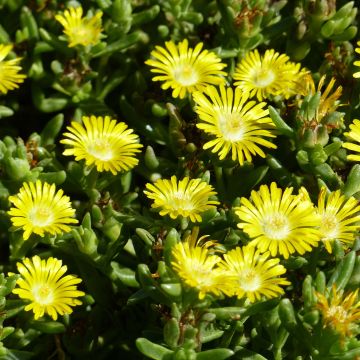
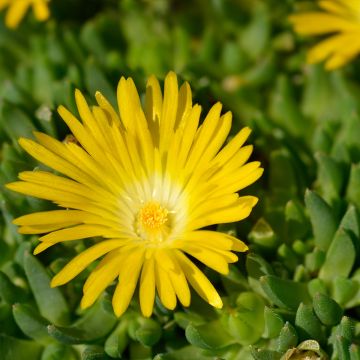
Comments